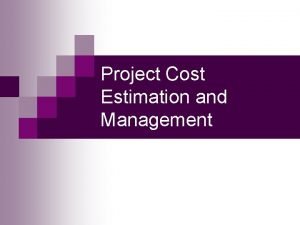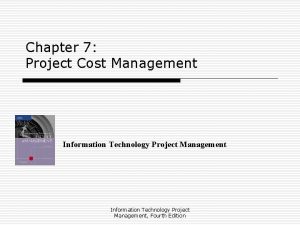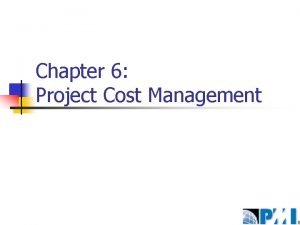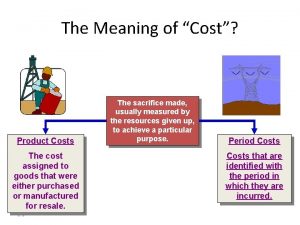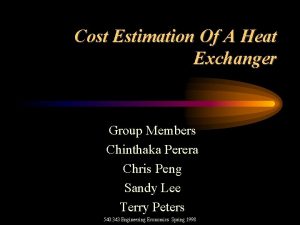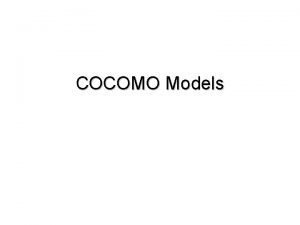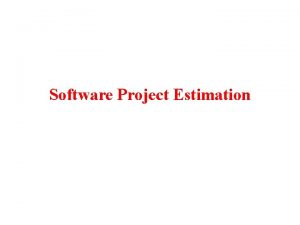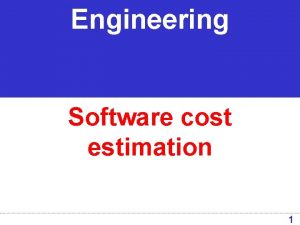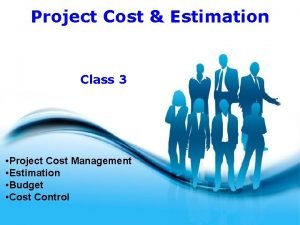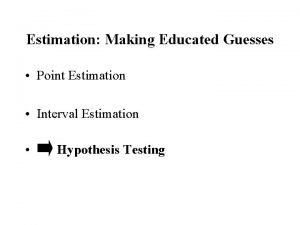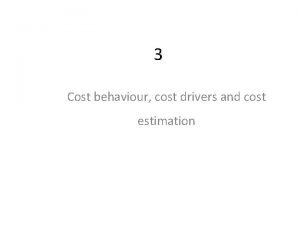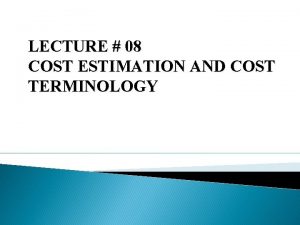Project Cost Estimation q What is Cost An









- Slides: 9

Project Cost Estimation q What is Cost? § An amount paid or required in payment for a purchase/for the production/upkeep of something. . measured in terms of effort/time expended. § Resources sacrificed/foregone to achieve a specific objective. § Cost is the amount of expenditure (actual or national), incurred on or attributable to, a specified thing or activity. § Cost is generally measured in monitory terms. § The term ‘cost’ will be meaningful only with a suffix or a prefix, with reference to some object. E. g. material, finance, BOP, Variable, indirect, process et al. 1

q Elements of Cost: § Basic elements: material, labour, expense ØMaterial – All materials required to be consumed, upto specified point ØLabour – All remuneration paid to the staff and workmen for conversion of raw materials into finished products. ØExpense – Cost of utilities and services used for the conversion process including notional cost for the use of owned assets. 2

q Further sub-division : § Direct Costs – can be identified with or related to the product / services § Indirect Costs – can not be identified/traced to a given object in an economical way § Basic cost elements shall be sub-divided into Direct and Indirect costs. § Prime cost – sum of Direct Costs § Overhead cost – sum of Indirect cost ØTypes of overhead cost: v. Production O/H, Admin O/H, Selling & Distribution O/H 3

q Summary : • • Direct (Matl. + labour + expenses) = Prime cost Prime Cost + Factory O/H = Factory cost + Admin O/H = Cost of Production + Selling & Dist. O/H = Cost of Sales 4

q Cost Allocation and Apportionment : § Cost Allocation – Allotment of the whole items of costs to cost centers / cost units § Cost Apportionment – Allotment of proportions of item of cost to cost centers / cost units § Direct costs are allocated to the cost center § Indirect costs are apportioned expenses. 5

q Cost Classification : § It is a process of grouping costs according to their common characteristics. E. g. Nature, function, variability, controllability, normality et al. § Essential for identifying costs with the cost center for the purposes of determination, control and decision making. 6

q Cost classification by variability : § Fixed costs – tend to remain unaffected by the change in volume of output. E. g. Supervisory salary, T & D § Variable costs – tend to vary directly with the volume of output. E. g. direct material § Semi fixed/ Semi-variable cost – tend to be partly fixed an partly variable. E. g. tel. Exp. , ele. bills 7

q Marginal Costing : § A principle of costing in which variable costs are charged to the cost center/unit and the fixed costs are written off in full, against the contribution § Contribution = (Sales – Variable cost of sales) § This contribution Margin (CM) is taken as basis for decision making pertaining to pricing, product-mix, Make Vs Buy et al. 8

 Cost control and cost reduction project report
Cost control and cost reduction project report Cost control and cost reduction project report
Cost control and cost reduction project report Objectives of cost estimation
Objectives of cost estimation Software cost estimation notes
Software cost estimation notes Methods of cost estimation in managerial economics
Methods of cost estimation in managerial economics Cost estimation table
Cost estimation table Objectives of cost management
Objectives of cost management Product cost estimation
Product cost estimation Shell and tube heat exchanger cost estimation
Shell and tube heat exchanger cost estimation What is cocomo model
What is cocomo model


